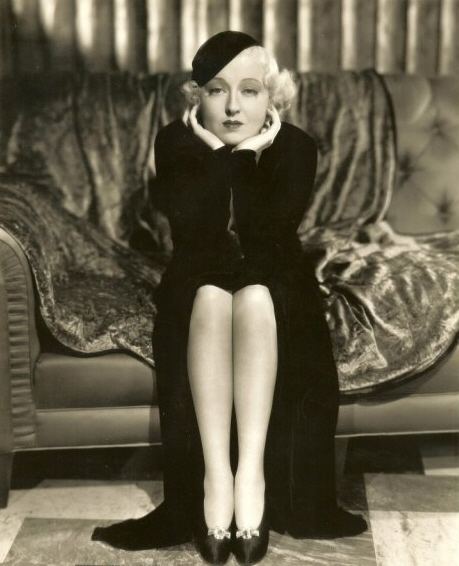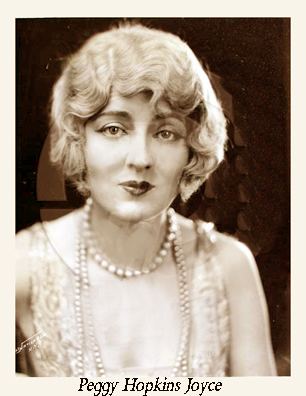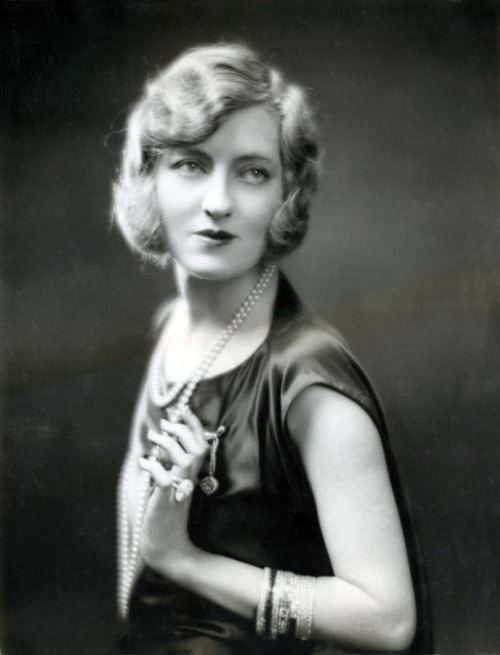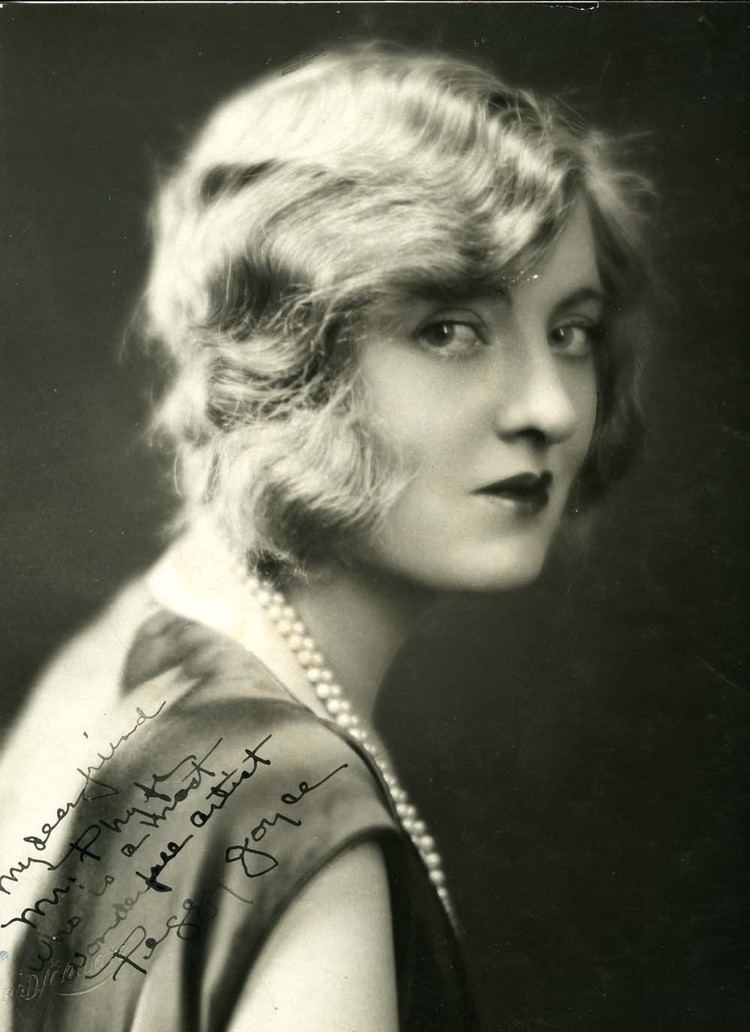Cause of death Throat cancer Role Actress | Name Peggy Joyce Years active 1916–1926 | |
 | ||
Full Name Marguerite Upton Education The Chevy Chase School for Girls Occupation Actress, artist model, dancer Movies International House, The Skyrocket, Dimples Spouse Andrew Meyer (m. 1953–1957) Similar People Sherburne Hopkins, A Edward Sutherland, Marshall Neilan | ||
Peggy Hopkins Joyce (May 26, 1893 – June 12, 1957) was an American actress, artist model and dancer. In addition to her performing career, Joyce was known for her flamboyant life, with numerous engagements, six marriages to wealthy men, subsequent divorces, a series of scandalous affairs, a collection of diamonds and furs, and her generally lavish lifestyle.
Contents

Early life

Born Marguerite Upton in 1893 in Berkley, Virginia (now part of Norfolk), she was known as "Peggy", a traditional nickname for Margaret or Marguerite. Upton left home at the age of 15 with a vaudeville bicyclist. While the two were en route to Denver via train, she met millionaire Everett Archer, Jr. She dumped the bicyclist and in 1910 married Archer. Archer had the marriage annulled after six months when he discovered Joyce was underage. Joyce later claimed she divorced Archer because the life of a millionaire's wife "was not at all what I thought it would be, and I was bored to death." Using the settlement money she received from Archer, Joyce attended the private Chevy Chase School for Girls in Washington D. C., where she met Sherburne Hopkins. Hopkins was a lawyer and son of a prominent, wealthy lawyer. They were married on September 1, 1913, when she was 20 years old.
Joyce left Hopkins in 1917 to pursue a career in show business in New York City. They eventually divorced in January 1920.
Career
Joyce made her Broadway debut in 1917 in the Ziegfeld Follies, followed by an appearance in the Shuberts' A Sleepless Night. She later had an affair with producer Lee Shubert for a time.
In 1920, she married her third husband, millionaire lumberman J. Stanley Joyce, and took his name. The newly married Mrs. Joyce drew attention for a $1 million shopping spree over the course of a week's time. By 1922, Joyce's romantic escapades had made her one of the most written-about women in the American press. She would grant any interview, sometimes receiving reporters in her bedroom while wearing a sheer negligee, sans undergarments. Cole Porter and Irving Berlin both used her name in their lyrics, The New Yorker magazine ran cartoons mentioning her, and comedians of the time, such as Will Rogers and Frank Fay could get a laugh by invoking her reputation.

Due to her notoriety, Joyce caused a sensation with her performance in the 1923 installment of the annual Earl Carroll's Vanities. She made her film debut in The Skyrocket (1926), which provoked the Wisconsin state legislature into introducing a bill to allow censorship of all movies entering the state. In any event, the film was a box office failure. In 1930, Joyce published a ghostwritten, "tell-all" book reputedly taken from her steamy diary entries. Men, Marriage and Me advised, "True love was a heavy diamond bracelet, preferably one that arrived with its price tag intact."

In 1933, Joyce played herself in the ramshackle film, International House, which contained some good-natured joshing about her love life.
Joyce owned a jewel known as the Portuguese Diamond, one of the most expensive in the world, which she sold to Harry Winston. It is displayed at the Smithsonian Institution in Washington, D.C.
Recounting a meeting with Joyce in the late 1920s, Harpo Marx claimed that she was illiterate. But, she was credited with writing a column in the early 1930s for the spicy New York publication Varieties (not to be confused with the show business trade publication Variety). The column reported gossip about the hijinks and goings-on among public figures in both New York and London.
Marriages and affairs
Joyce was married six times and claimed to be engaged around fifty times.
Joyce's first marriage was to millionaire Everett Archer, Jr. in 1910. Archer had the marriage annulled later that year after he discovered that Joyce was underage. Her second marriage was to lawyer Sherburne Hopkins, the son of a prominent and wealthy lawyer. They were married in 1913. In 1917, Joyce left him to pursue a career. While traveling with the Ziegfeld show in 1919, she met wealthy Chicago lumberman J. Stanley Joyce. J. Stanley Joyce paid for Peggy's divorce from Hopkins. Their divorced was granted on January 21, 1920.
Two days later, on January 23, Peggy and J. Stanley Joyce were married. On their wedding night, Peggy locked herself in the bathroom of the couple's hotel room and refused to come out until Joyce wrote her a check for $500,000. Within the year, she left Stanley Joyce for Parisian playboy and multimillionaire newspaper owner Henri Letellier. She sued J. Stanley Joyce for divorce and asked for $10,000 a month in alimony and attorney fees of $100,000. J. Stanley Joyce counter sued, claiming that she had married him only to defraud him of money. He also accused Peggy of having multiple adulterous affairs, being a bigamist (Stanley Joyce claimed that Peggy was not divorced from her first husband before she married her second, thus making their union invalid), and for having driven a United States Army lieutenant to suicide. J. Stanley Joyce's lawyer claimed the man shot himself in a Turkish bath after going broke trying to keep Peggy happy.
During the couple's well publicized divorce trial in 1921, testimony revealed that J. Stanley had given Peggy Joyce a reported $1.4 million in jewelry, a $300,000 home in Miami, furs, cars, and other properties during their marriage. Joyce was awarded $600,000 in the divorce settlement. She was also allowed to keep all the jewelry she had acquired during the marriage, and was given stock in J. Stanley Joyce's lumber company that allotted her an annuity of $1,500 monthly for life.
The media later reported that Joyce had eloped with Henri Letellier, but the two never married. She later said that she did not marry him because "Frenchmen understand women too well. A girl should never marry a man who understands women." After her third divorce, Joyce declared that she would never marry again.
For the next few years, Joyce remained single but continued to have numerous affairs with such wealthy men as W. Averell Harriman, Prince Christopher of Greece and Denmark, Hiram Bloomingdale (son of Lyman G. Bloomingdale), Sayajirao Gaekwad III, Charlie Chaplin (who based part of his film A Woman of Paris on stories Joyce told him about her previous marriage), and film producer Irving Thalberg.
In 1922, Joyce's affair with the attaché of the Chilean Legation, Guillermo "William" Errázuriz, drew media attention as he was the brother of the equally scandalous Blanca Errázuriz. The affair began while she was still in a relationship with Henri Letellier. Errázuriz was married with a child, but Joyce claimed he wanted to marry her. On May 1, 1922, Errázuriz shot himself in Joyce's Paris hotel room and died the following day. Joyce claimed that he committed suicide after she refused to marry him. Errázuriz's family claimed that he killed himself due to financial problems.
Three days after Errázuriz's death, on May 4, Joyce was hospitalized after accidentally overdosing on sleeping pills. While she was recuperating, she gave an interview to a reporter claiming that she was "...through with men." Joyce went on to say that she was in love with William Errázuriz but admitted that she "...played with him. I dangled him on a string just as I did many others. Oh, why did I do it?" When asked why numerous men were seemingly fascinated by her, Joyce stated, "I don't know why men run after me. I cannot tell you the secret of my fascination. [...] I never meant to ruin their lives." Nine days after Errázuriz's death, another attaché of the Chilean Legation linked to Joyce, Lt. Rivas Muntt, attempted suicide by overdosing on Veronal. Muntt reportedly became despondent when Joyce spurned his advances and was found clutching a newspaper clipping of the interview in which Joyce declared her love for Errázuriz.
Despite her declaration never to marry again, Joyce married Swedish Count Gosta Morner on June 3, 1924. Joyce told the press that "All my other marriages meant nothing. This is the first time I have ever been truly in love." Count Morner told reporters that Joyce would give up her career in order to be his wife. By the end of July 1924, Joyce had decided to resume her career and left Count Morner. They divorced in February 1926. Joyce remained single for the next nineteen years but continued dating several wealthy men. In the early 1930s, she began an affair with Walter Chrysler, who was married at the time. Chrysler reportedly gave her $2 million in jewelry (including a 134-karat diamond necklace which cost a reported $500,000) and two Isotta Fraschinis – a canary yellow roadster and a Tipo 8B – worth $45,000. Joyce later had a relationship with British astronomy professor Charles Vivian Jackson. Jackson died in a sleighing accident when the couple were in St. Moritz in 1937. Joyce would later claim that Jackson was "the only man I ever loved."
On December 3, 1945, Joyce married for the fifth time to consulting engineer Anthony Easton. The marriage made headlines when Joyce refused to include the word "obey" in the marriage vows. Although there is no record of a divorce, Joyce and Easton's union ended sometime before 1953.
In 1953, Joyce married for the sixth and final time to Andrew C. Meyer. Meyer was described as a "retired official of the Bankers Trust Company". Meyer was actually a retired bank teller whom Joyce had met while he was working at a bank that she used. They remained married until Joyce's death in 1957.
Later years and death
After marrying her sixth husband in 1953, Joyce moved to Woodbury, Connecticut where she spent her remaining years. On June 1, 1957, she was admitted to Memorial Hospital for Cancer and Allied Diseases in New York City after being diagnosed with throat cancer. Joyce died there on June 12, 1957 at the age 64.
Joyce is buried at Gate of Heaven Cemetery in Hawthorne, New York.
